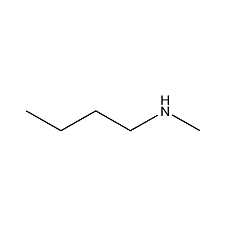
Structural formula
| Business number | 031T |
|---|---|
| Molecular formula | C5H13N |
| Molecular weight | 87.16 |
| label |
Methylbutylamine, N-Butyl-N-methylamine, Methyl n-butylamine, Butylmethylamine, N-Butyl-N-methylamin, Butylmethylamine, Methylbutylamine, Methyl-n-butylamine, linear compound |
Numbering system
CAS number:110-68-9
MDL number:MFCD00009426
EINECS number:203-791-2
RTECS number:EO5250000
BRN number:1209231
PubChem number:24849970
Physical property data
1. Properties: Colorless liquid, volatile, with strong ammonia smell. [1]
2. Melting point (℃): -75[2]
3. Boiling point (℃): 90.5~91.5[3]
4. Relative density (water=1): 0.74[4]
5. Relative vapor density (air = 1): 3.0[5]
6. Octanol/water partition coefficient: 1.33[6]
7. Flash point (℃): 13 (OC) [7]
8. Solubility: miscible with water and miscible with ethanol. [8]
Toxicological data
1. Acute toxicity[9] LD50: 420mg/kg (rat oral); 1260mg/kg (mouse oral Oral)
2. Irritation[10]
Rabbit transdermal: 100μg (24h), causing irritation (open stimulation test)
Rabbit eye: 74mg, severe irritation.
Ecological data
1. Ecotoxicity No data available
2. Biodegradability No data available
3 .Non-biodegradable[11] In the air, when the concentration of hydroxyl radicals is 5.00×105/cm3, the degradation half-life is 5h (theoretical).
4. Other harmful effects[12] This substance is harmful to the environment. Special attention should be paid to the pollution of water bodies.
Molecular structure data
1. Molar refractive index: 28.80
2. Molar volume (cm3/mol): 119.8
3. Isotonic specific volume (90.2K ): 259.0
4. Surface tension (dyne/cm): 21.7
5. Polarizability (10-24cm3): 11.42
Compute chemical data
1. Reference value for hydrophobic parameter calculation (XlogP): None
2. Number of hydrogen bond donors: 1
3. Number of hydrogen bond acceptors: 1
4. Number of rotatable chemical bonds: 3
5. Number of tautomers: none
6. Topological molecule polar surface area 12
7.Number of heavy atoms: 6
8. Surface charge: 0
9. Complexity: 19.9
10. Number of isotope atoms: 0
11. Determine the atoms Number of stereocenters: 0
12. Uncertain number of stereocenters of atoms: 0
13. Determined number of stereocenters of chemical bonds: 0
14. Uncertain number of stereocenters of chemical bonds: 0
15. Number of covalent bond units: 1
Properties and stability
1. Stability[13] Stable
2. Incompatible substances [14] Strong oxidants, acids, acid anhydrides, acid chlorides
3. Polymerization hazards[15 ] No polymerization
4. Decomposition products[16] Ammonia
Storage method
Storage Precautions[17] Store in a cool, ventilated warehouse. Keep away from fire and heat sources. The storage temperature should not exceed 37°C. Keep container tightly sealed. They should be stored separately from oxidants, acids, etc., and avoid mixed storage. Use explosion-proof lighting and ventilation facilities. It is prohibited to use mechanical equipment and tools that are prone to sparks. The storage area should be equipped with emergency release equipment and suitable containment materials.
Synthesis method
Purpose
Used in organic synthesis. [18]

 微信扫一扫打赏
微信扫一扫打赏

